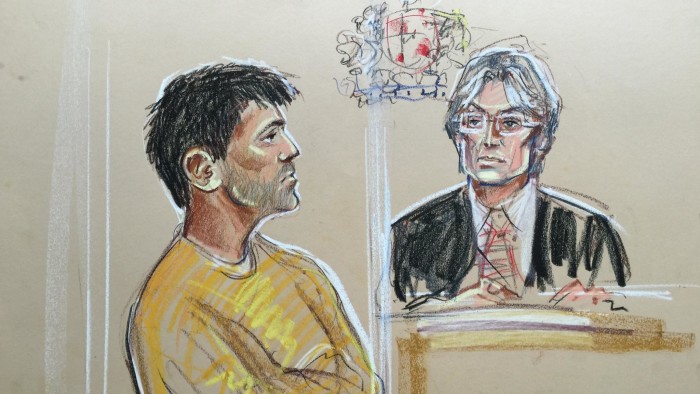Flash crash trader at centre of web of offshore accounts

Roula Khalaf, Editor of the FT, selects her favourite stories in this weekly newsletter.
The west London trader charged with contributing to a sudden crash in US equity markets five years ago set up companies in the Caribbean and moved millions of pounds between offshore accounts in Switzerland, Dubai and elsewhere, US regulators have alleged.
Documents released by the Commodity Futures Trading Commission, together with filings with UK authorities examined by the Financial Times, reveal a complex structure of accounts used by Navinder Singh Sarao, who has been arrested on allegations that he helped cause the 2010 “flash crash” that left regulators scrambling to reassure investors.
In the financial year covering the sudden market plunge, where his trading attracted the attention of US authorities, Companies House filings showed his company’s net assets more than doubling to almost £41.8m, while about £21.5m was moved to a family trust.
Over a five-year period, the US Department of Justice and the CFTC allege, Mr Sarao made about $40m in profit using spoofing techniques that involve putting in an order and swiftly withdrawing it before a trade can take place.
He has been described as a lone trader who lives with his parents in Hounslow and drives an old car. But email exchanges presented as part of the US government’s case show a man who pressed trading software technicians to modify programs so he could trade faster, even as he criticised high-frequency traders as manipulative.
The 36-year-old used MF Global, Marex, Knight Futures (briefly) and RJ O’Brien as his brokers for trading, and explained his moves as being those of a “trader who changes his mind very very quickly,” according to an email he sent to the UK Financial Conduct Authority in May 2014.
“What makes me change my mind? Well it could be anything,” Mr Sarao wrote. “A move in one of the other markets that I look at, a chart set up that I suddenly remember from my 11 years of trading, or simply the WAY I was filled made me doubt my position, or for the large part it is just my INTUITION.”
CME faces scrutiny over warning signs on ‘flash crash trader’

‘Spoofing’ charges against a UK trader turn spotlight on self-regulatory organisations once again.
Continue reading
Mr Sarao made several unusual moves around the time of the flash crash, which seem to have heralded the start of the “complex structures” that held his funds and ensured most of his profit was put in offshore accounts, according to the exhibits and filings.
Before 2010, Mr Sarao had submitted annual statements for a financial year ending on June 30. However, that year he shortened the accounting period to end the reporting period on April 30 2010, which excluded the flash crash of May 6 2010, according to Companies House filings.
In late April 2010, Mr Sarao also established Nav Sarao Milking Markets Limited in the Caribbean island of Nevis. In 2012, he set up the International Guarantee Corporation incorporated in Anguilla, also in the West Indies. The DoJ alleges both were set up to avoid taxes.
Two days before the flash crash, Mr Sarao’s Nav Sarao Futures Limited listed a notice of a security agreement with Credit Suisse’s UK office, but the filings do not go into detail.
Companies House filings for the year to April 30 2011 show Mr Sarao more than doubling the amount of assets held in his trading company from about £18.8m to about £41.8m.
In that period, Mr Sarao listed £21.5m in a family trust, the Nav Sarao Futures Ltd Employee Settlement, which controlled his trading company and was also used to loan money to Mr Sarao’s company. About £20.3m was held in cash at a bank, according to the filing.
In 2010, Mr Sarao developed an offshore trust structure to “make use of substantial accumulated profits” in his trading company in a “tax efficient” manner, according to court exhibits filed by the CFTC.
But from 2011 to 2012, Mr Sarao listed a loss of about £27m, partly due to a change in accounting rules for employee benefit trusts. Over that period, Mr Sarao also withdrew £3.7m from his company, Nav Sarao Futures, the filing said.
The accounting rule changes led to the establishment of an offshore insurance bond with Mr Sarao as a policyholder and with the International Guarantee Corporation as the underlying company. The IGC then entered into guarantee arrangements with Mr Sarao’s trading company to facilitate trades.
By 2012, Mr Sarao had almost $17m in an account at Hinduja Bank in Switzerland, but later that year, he proposed transferring funds to the United Arab Bank in Dubai, according to court exhibits filed by the CFTC.
The sums are starkly different from those he started with. UK company filings show Mr Sarao launched his company in 2005 with a zero balance. He ended his first year in operation with a profit of £33,085 and a balance of £23,085, according to a filing for the year to July 31 2006.
By 2007, however, he claimed to be making such sums in a matter of hours. That November, Mr Sarao emailed the publisher of a shortlived glossy Wall Street magazine called Trader Monthly, asking about the criteria for its 30 under 30 list, according to court exhibits.
“If I trade well on a volatile day I normally make circa $133,000. On quiter [sic] days I look to make between $45,000 and $70,000,” he wrote. He preferred to keep a low profile, he added, but some publicity could help him set up a trading arcade — a facility where several “local” or individual investors can have access to the trading technology they need.
“You must understand that for me to be in the top 30 is not a vanity thing.”
Comments